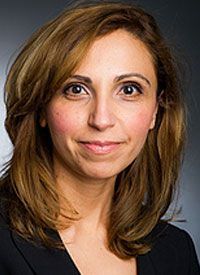Article
MMRF CureCloud® Aims to Accelerate Precision Medicine With Real-World Data in Myeloma
Author(s):
The Multiple Myeloma Research Foundation CureCloud® is a first-of-its-kind research initiative, developed to help arm researchers with the information they need to accelerate development of novel therapeutic strategies, provide a precision medicine approach to help inform providers’ and patients’ treatment decisions, and ultimately, find a cure for multiple myeloma.
Hearn Jay Cho, MD, PhD

Although the treatment of patients with multiple myeloma has improved significantly with the introduction of novel therapies and combinations, the complexity of the disease presents considerable challenges to the care team.
The Multiple Myeloma Research Foundation (MMRF) CureCloud® (NCT03657251) is a first of its kind research initiative that was developed to help arm researchers with the information they need to accelerate development of novel therapeutic strategies, provide a precision medicine approach to help inform providers’ and patients’ treatment decisions, and ultimately, find a cure for multiple myeloma.1
“The current landscape for myeloma is a significant improvement over previous eras,” said Hearn Jay Cho, MD, PhD, an associate professor of medicine of Hematology and Medical Oncology at the Icahn School of Medicine at Mount Sinai Hospital and Chief Medical Officer at the MMRF. “We have an unprecedented number of new treatments for multiple myeloma and overall survival for the average patient is getting longer. However, with all this great progress, there are still [patients] who need our help. In particular, there is a subset of high-risk multiple myeloma patients who at diagnosis and at relapse do significantly worse than their peers.”
Sponsored by the MMRF, CureCloud, launched on July 14, 2020, marks the “first, largest, and most comprehensive study of its kind” in multiple myeloma, harnessing the use of bioinformatics to push the field of multiple myeloma toward precision medicine, while democratizing access to next generation sequencing (NGS) for patients who may not otherwise have access.
CureCloud builds on findings from the MMRF CoMMpass study (NCT01454297)2, which discovered and confirmed several actionable genomic alterations in myeloma and is currently the largest genomic dataset in any cancer. To date, CoMMpass has identified at least 8 unique genomic subtypes of myeloma using data from over 1100 participants with newly diagnosed disease who are longitudinally followed over 8 years.
Irene Ghobrial, MD

“When we started thinking [about] this 2 years ago, [I knew] only MMRF could truly pull this together,” said Irene Ghobrial, MD, a professor of medicine at Harvard Medical School and director of the Clinical Investigator Research Program at Dana-Farber Cancer Institute. “You [are] empowering patients [in that] they can sign up online and [have the ability] to be part of the research question…Now we are bringing in the next step which is giving back to the patient their own information. That is the unique power of CureCloud.”
The goal of this innovative study is to enroll at least 5000 patients and collect real-world data that can be applied to clinical research and development. Moreover, the data from the study will allow patients to have a well-informed voice in their own treatment selection and enable physicians to make data-driven treatment recommendations for their patients.
Cell-free DNA from patient blood samples will be tested to identify common and potentially actionable somatic mutations using a unique, 70-gene panel that was developed in a collaborative effort between MMRF, the Dana-Farber Cancer Institute, and the Broad Institute of MIT and Harvard, using data derived from the CoMMpass study. Notably, the assay is the only liquid biopsy available to patients with multiple myeloma.
The state-of-the-art NGS assay is offered to patients at no cost and can be repeated should a patient’s disease change or progress.
“The liquid biopsy assay is a critical part of this project,” explained Cho. “There are certain genes that are associated with cancer that are often mutated or altered in patients with different types of cancer. Some of these mutations turn out to be very common in multiple myeloma.”
In a streamlined process and at no cost to the patient or provider, patients can register with CureCloud online, complete consent and medical release forms, and supply the names of their treating physicians, so that their electronic health records (EHR) may be obtained. Patients supply a blood draw order form to their primary oncologist for approval for the liquid biopsy. Subsequently, patients schedule an appointment with a mobile phlebotomist who will come to the patient’s home to do a blood draw. The samples are then shipped to the MMRF’s collaborator, the Broad Institute of MIT and Harvard, for NGS genomic analysis.
Blood samples will also be stored at the MMRF Tissue Bank at the Mayo Clinic in Scottsdale AZ for future laboratory analyses including immune profiling.
Notably, patient privacy will be protected throughout the study. Records are stored in the CureCloud database, blood samples are coded and de-identified upon analysis, and any identifying patient information will not be included in the information available to researchers.
Both patients and physicians will receive a comprehensive analysis of the genomic testing results, along with information on any appropriate clinical trials, within 4 to 8 weeks of testing. The patient report will be written in digestible, easy-to-understand language so as to empower the patient with information rather than increase confusion or anxiety.
The physician report includes a breakdown of potentially actionable somatic alterations and expert comments from a molecular pathologist, as well as a list of available clinical trials.
For the patient report, background information on their somatic mutations is provided in addition to the potential clinical trials.
Sample reports are available to preview on the CureCloud website for patients or physicians interested in seeing what they will receive should they participate in the study. An overview of medications FDA-approved in other tumor types targeting actionable somatic mutations that are under investigation in myeloma can also be accessed by physicians on the CureCloud website.
Genomic data will be aggregated with clinical data extracted from EHR records to provide a comprehensive profile of each patient’s disease. Eventually, other data will be added including immune profiling analyses and patient reported outcomes, among others.
The genomic data compiled from CureCloud will further stratify the incidence of common alterations and provide clinical insight on optimizing treatment pathways and targeted therapies based on patient characteristics and various myeloma subtypes.
“We are just scratching the surface of what CureCloud can do, because we are aggregating an enormous amount of information that can be viewed through many lenses,” said Cho. “Clinical researchers are going to look for the next clinical trial and the next target [while] biologists and bioinformaticians may look at this as an opportunity to understand how a biological network works. There are going to be pathways that we don’t recognize yet.”
Some of these potential directions include geographic distribution and multiple myeloma care, as well as the interaction between genomics and immunology, Cho added.
The majority of patients with active multiple myeloma requiring treatment who are living in the United States are eligible to enroll in the CureCloud study. Patients living in New York, Hawaii, and Alaska are not eligible to enroll in CureCloud at this time.
Additionally, although patients with smoldering myeloma are not yet able to register, Ghobrial is hopeful that the study will soon be available to these patients. The CureCloud will be collaborating with the PROMISE study (NCT03689595)3, for which Ghobrial is the lead investigator to include patients with smoldering myeloma in the CureCloud in the near future. In the PROMISE study, healthy, but high-risk, individuals will be screened for early signs of multiple myeloma. The goal of the study is to make multiple myeloma a preventable disease through early identification of higher-risk individuals.
“As a physician, every time I see one of my patients, they ask me, ‘What kind of myeloma do I have?’” said Ghobrial. “Every patient is an individual. We should individualize therapy as much as we can…We are being empowered by more precision and more information through CureCloud to [provide relevant information] to the patient.”
With its unique direct-to-patient concept and cutting-edge science, CureCloud has the power to impact patients’ lives, said Cho. Moreover, for both physicians and patients alike, CureCloud has the ability to make precision medicine a reality for the myeloma community.
To learn more about the MMRF CureCloud, visit MMRFCureCloud.org/physicians. To find out more information about the PROMISE study, visit Enroll.PROMISEstudy.org.
References:
- The MMRF CureCloud®. Multiple Myeloma Research Foundation. 2020. Accessed July 9, 2020. bit.ly/32fET4D.
- MMRF CoMMpass study: an update. Multiple Myeloma Research Foundation. 2020. July 9, 2020. bit.ly/2BPiUH3.
- The PROMISE study. 2020. July 9, 2020. bit.ly/2ZQTiRW.









